Fair Work Commission's Role in Oaky Creek Coal Dispute Resolution
VerifiedAdded on 2021/06/17
|15
|3168
|78
Report
AI Summary
This report examines the industrial dispute between Oaky Creek Coal Pty Ltd and the Construction, Forestry, Mining and Energy Union (CFMEU). It provides background on the dispute, which stemmed from disagreements over a new enterprise agreement, and analyzes the roles of both parties, including the Fair Work Commission (FWC). The report details the history of the conflict, including past disputes and the current situation, highlighting the implications on Glencore's reputation. It analyzes the FWC's role in dispute resolution, including the processes involved and the effectiveness of its intervention, while also touching upon the limitations of unions. The report concludes with recommendations based on the evaluation of the dispute, offering insights into the protracted nature of the conflict and the challenges in achieving a resolution. The report covers key aspects of the dispute, including the lockout of workers, the involvement of local MPs, and the final resolution, emphasizing the importance of communication and negotiation in resolving industrial conflicts.
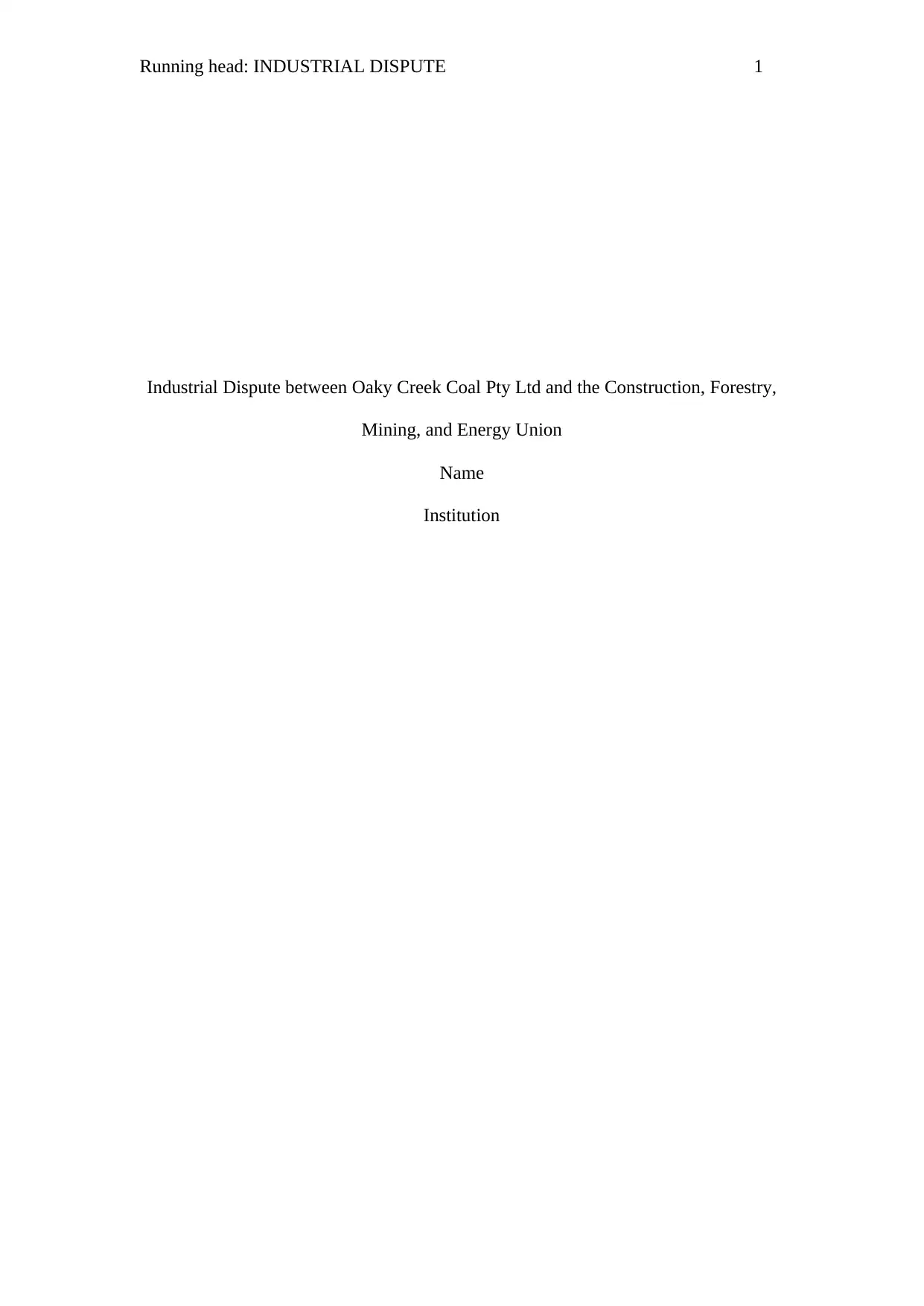
Running head: INDUSTRIAL DISPUTE 1
Industrial Dispute between Oaky Creek Coal Pty Ltd and the Construction, Forestry,
Mining, and Energy Union
Name
Institution
Industrial Dispute between Oaky Creek Coal Pty Ltd and the Construction, Forestry,
Mining, and Energy Union
Name
Institution
Paraphrase This Document
Need a fresh take? Get an instant paraphrase of this document with our AI Paraphraser
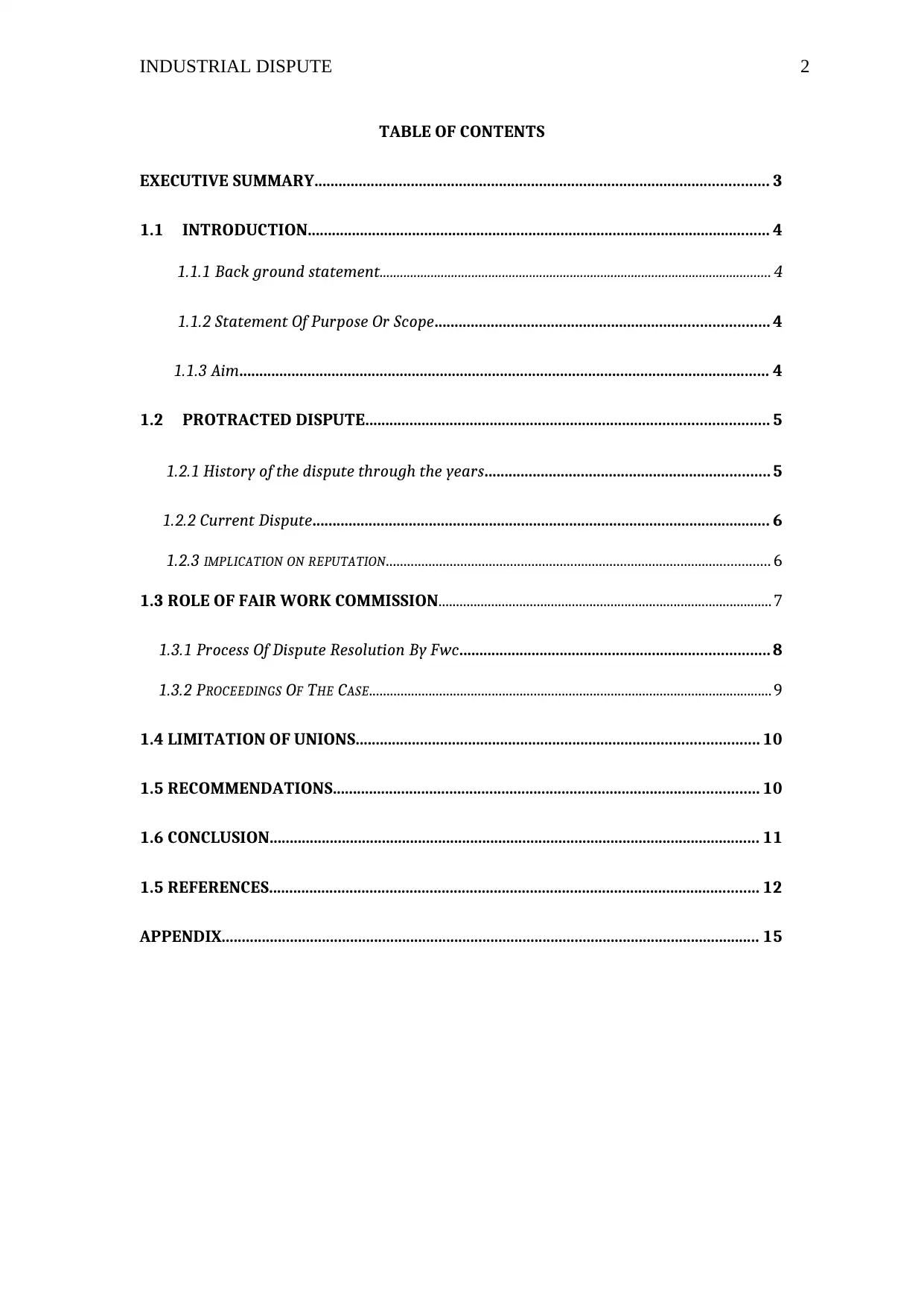
INDUSTRIAL DISPUTE 2
TABLE OF CONTENTS
EXECUTIVE SUMMARY................................................................................................................. 3
1.1 INTRODUCTION................................................................................................................... 4
1.1.1 Back ground statement................................................................................................................... 4
1.1.2 Statement Of Purpose Or Scope................................................................................... 4
1.1.3 Aim.................................................................................................................................... 4
1.2 PROTRACTED DISPUTE.................................................................................................... 5
1.2.1 History of the dispute through the years....................................................................... 5
1.2.2 Current Dispute.................................................................................................................. 6
1.2.3 IMPLICATION ON REPUTATION............................................................................................................ 6
1.3 ROLE OF FAIR WORK COMMISSION...............................................................................................7
1.3.1 Process Of Dispute Resolution By Fwc............................................................................. 8
1.3.2 PROCEEDINGS OF THE CASE...................................................................................................................9
1.4 LIMITATION OF UNIONS.................................................................................................... 10
1.5 RECOMMENDATIONS.......................................................................................................... 10
1.6 CONCLUSION.......................................................................................................................... 11
1.5 REFERENCES.......................................................................................................................... 12
APPENDIX...................................................................................................................................... 15
TABLE OF CONTENTS
EXECUTIVE SUMMARY................................................................................................................. 3
1.1 INTRODUCTION................................................................................................................... 4
1.1.1 Back ground statement................................................................................................................... 4
1.1.2 Statement Of Purpose Or Scope................................................................................... 4
1.1.3 Aim.................................................................................................................................... 4
1.2 PROTRACTED DISPUTE.................................................................................................... 5
1.2.1 History of the dispute through the years....................................................................... 5
1.2.2 Current Dispute.................................................................................................................. 6
1.2.3 IMPLICATION ON REPUTATION............................................................................................................ 6
1.3 ROLE OF FAIR WORK COMMISSION...............................................................................................7
1.3.1 Process Of Dispute Resolution By Fwc............................................................................. 8
1.3.2 PROCEEDINGS OF THE CASE...................................................................................................................9
1.4 LIMITATION OF UNIONS.................................................................................................... 10
1.5 RECOMMENDATIONS.......................................................................................................... 10
1.6 CONCLUSION.......................................................................................................................... 11
1.5 REFERENCES.......................................................................................................................... 12
APPENDIX...................................................................................................................................... 15
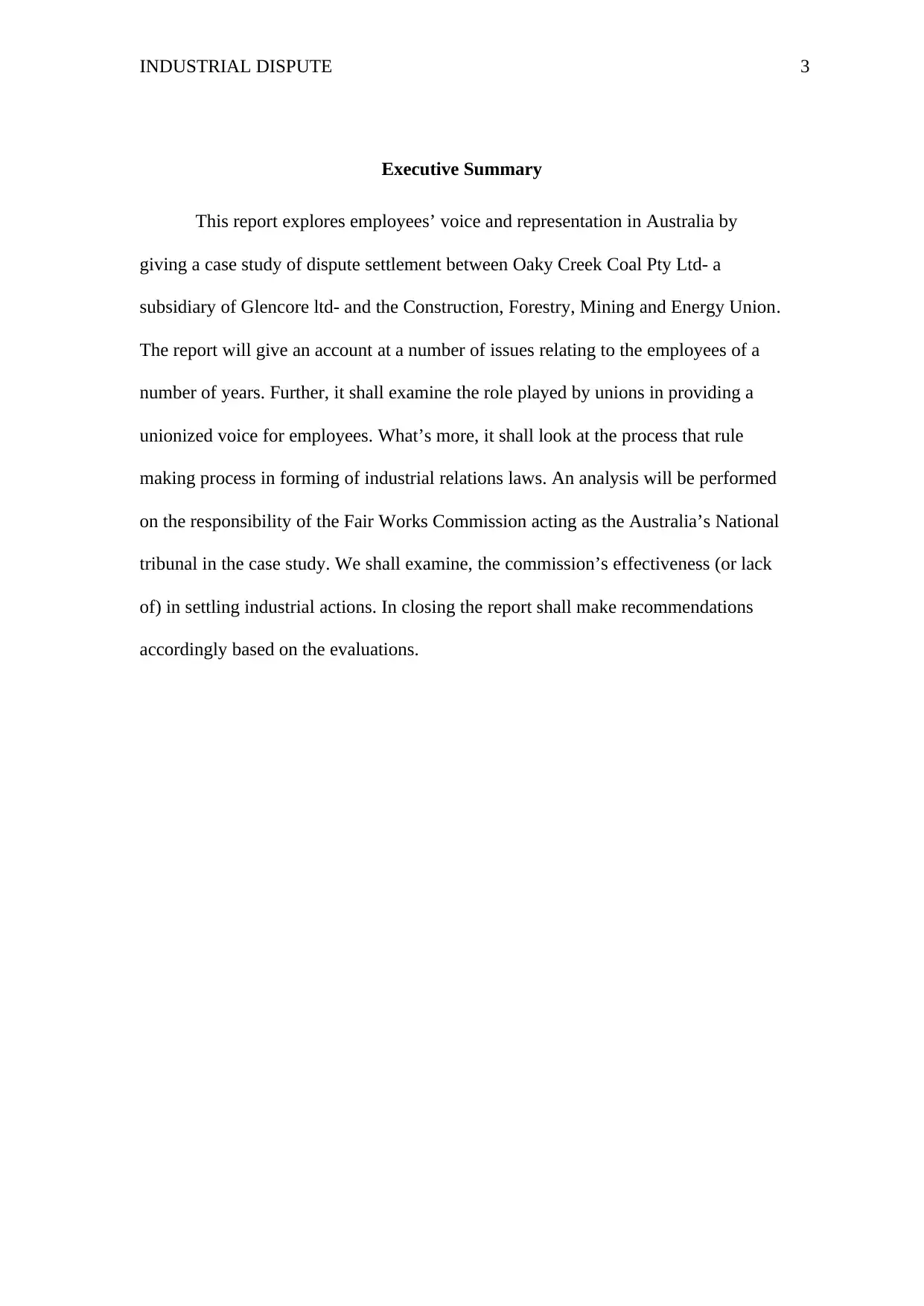
INDUSTRIAL DISPUTE 3
Executive Summary
This report explores employees’ voice and representation in Australia by
giving a case study of dispute settlement between Oaky Creek Coal Pty Ltd- a
subsidiary of Glencore ltd- and the Construction, Forestry, Mining and Energy Union.
The report will give an account at a number of issues relating to the employees of a
number of years. Further, it shall examine the role played by unions in providing a
unionized voice for employees. What’s more, it shall look at the process that rule
making process in forming of industrial relations laws. An analysis will be performed
on the responsibility of the Fair Works Commission acting as the Australia’s National
tribunal in the case study. We shall examine, the commission’s effectiveness (or lack
of) in settling industrial actions. In closing the report shall make recommendations
accordingly based on the evaluations.
Executive Summary
This report explores employees’ voice and representation in Australia by
giving a case study of dispute settlement between Oaky Creek Coal Pty Ltd- a
subsidiary of Glencore ltd- and the Construction, Forestry, Mining and Energy Union.
The report will give an account at a number of issues relating to the employees of a
number of years. Further, it shall examine the role played by unions in providing a
unionized voice for employees. What’s more, it shall look at the process that rule
making process in forming of industrial relations laws. An analysis will be performed
on the responsibility of the Fair Works Commission acting as the Australia’s National
tribunal in the case study. We shall examine, the commission’s effectiveness (or lack
of) in settling industrial actions. In closing the report shall make recommendations
accordingly based on the evaluations.
⊘ This is a preview!⊘
Do you want full access?
Subscribe today to unlock all pages.

Trusted by 1+ million students worldwide
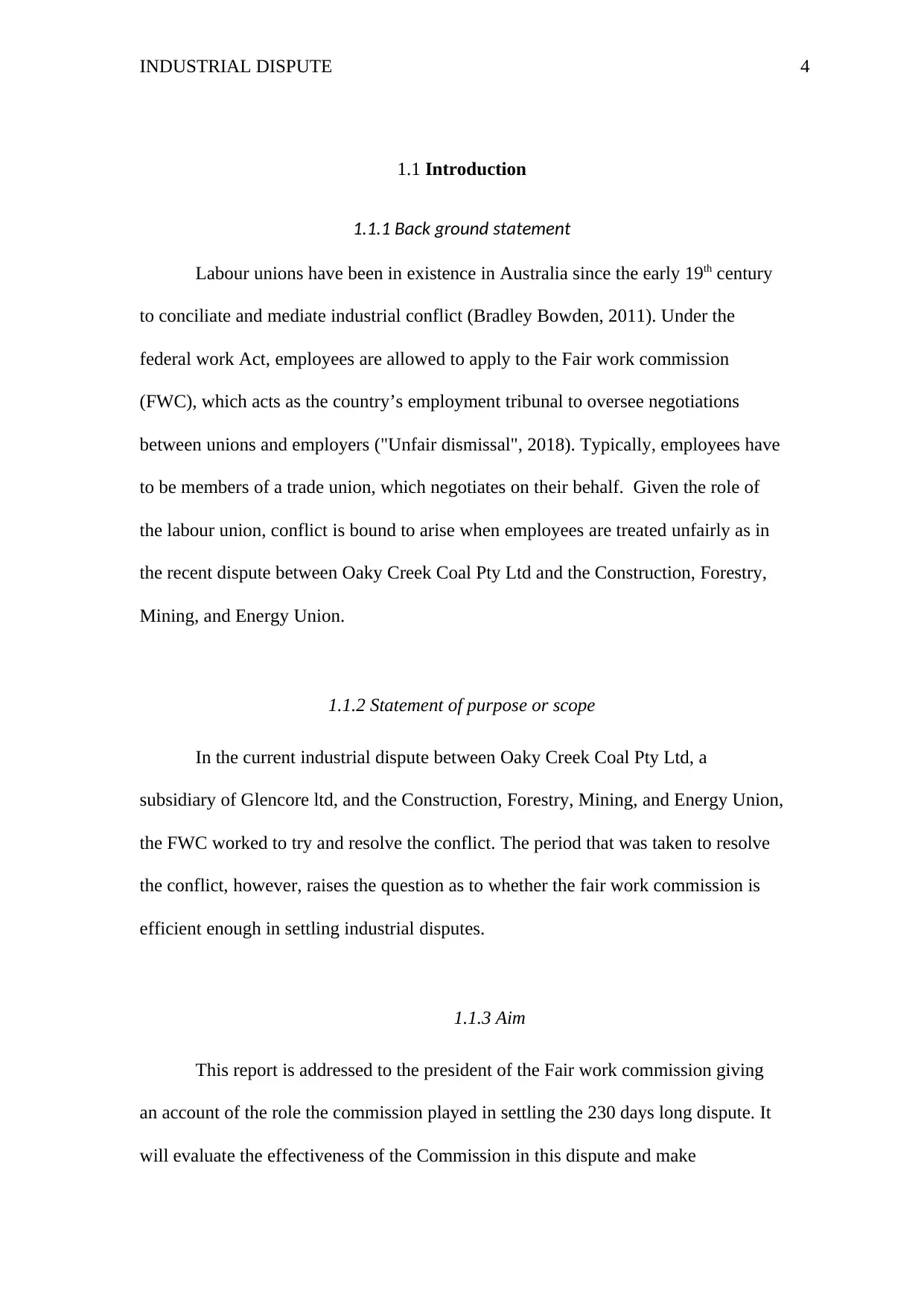
INDUSTRIAL DISPUTE 4
1.1 Introduction
1.1.1 Back ground statement
Labour unions have been in existence in Australia since the early 19th century
to conciliate and mediate industrial conflict (Bradley Bowden, 2011). Under the
federal work Act, employees are allowed to apply to the Fair work commission
(FWC), which acts as the country’s employment tribunal to oversee negotiations
between unions and employers ("Unfair dismissal", 2018). Typically, employees have
to be members of a trade union, which negotiates on their behalf. Given the role of
the labour union, conflict is bound to arise when employees are treated unfairly as in
the recent dispute between Oaky Creek Coal Pty Ltd and the Construction, Forestry,
Mining, and Energy Union.
1.1.2 Statement of purpose or scope
In the current industrial dispute between Oaky Creek Coal Pty Ltd, a
subsidiary of Glencore ltd, and the Construction, Forestry, Mining, and Energy Union,
the FWC worked to try and resolve the conflict. The period that was taken to resolve
the conflict, however, raises the question as to whether the fair work commission is
efficient enough in settling industrial disputes.
1.1.3 Aim
This report is addressed to the president of the Fair work commission giving
an account of the role the commission played in settling the 230 days long dispute. It
will evaluate the effectiveness of the Commission in this dispute and make
1.1 Introduction
1.1.1 Back ground statement
Labour unions have been in existence in Australia since the early 19th century
to conciliate and mediate industrial conflict (Bradley Bowden, 2011). Under the
federal work Act, employees are allowed to apply to the Fair work commission
(FWC), which acts as the country’s employment tribunal to oversee negotiations
between unions and employers ("Unfair dismissal", 2018). Typically, employees have
to be members of a trade union, which negotiates on their behalf. Given the role of
the labour union, conflict is bound to arise when employees are treated unfairly as in
the recent dispute between Oaky Creek Coal Pty Ltd and the Construction, Forestry,
Mining, and Energy Union.
1.1.2 Statement of purpose or scope
In the current industrial dispute between Oaky Creek Coal Pty Ltd, a
subsidiary of Glencore ltd, and the Construction, Forestry, Mining, and Energy Union,
the FWC worked to try and resolve the conflict. The period that was taken to resolve
the conflict, however, raises the question as to whether the fair work commission is
efficient enough in settling industrial disputes.
1.1.3 Aim
This report is addressed to the president of the Fair work commission giving
an account of the role the commission played in settling the 230 days long dispute. It
will evaluate the effectiveness of the Commission in this dispute and make
Paraphrase This Document
Need a fresh take? Get an instant paraphrase of this document with our AI Paraphraser
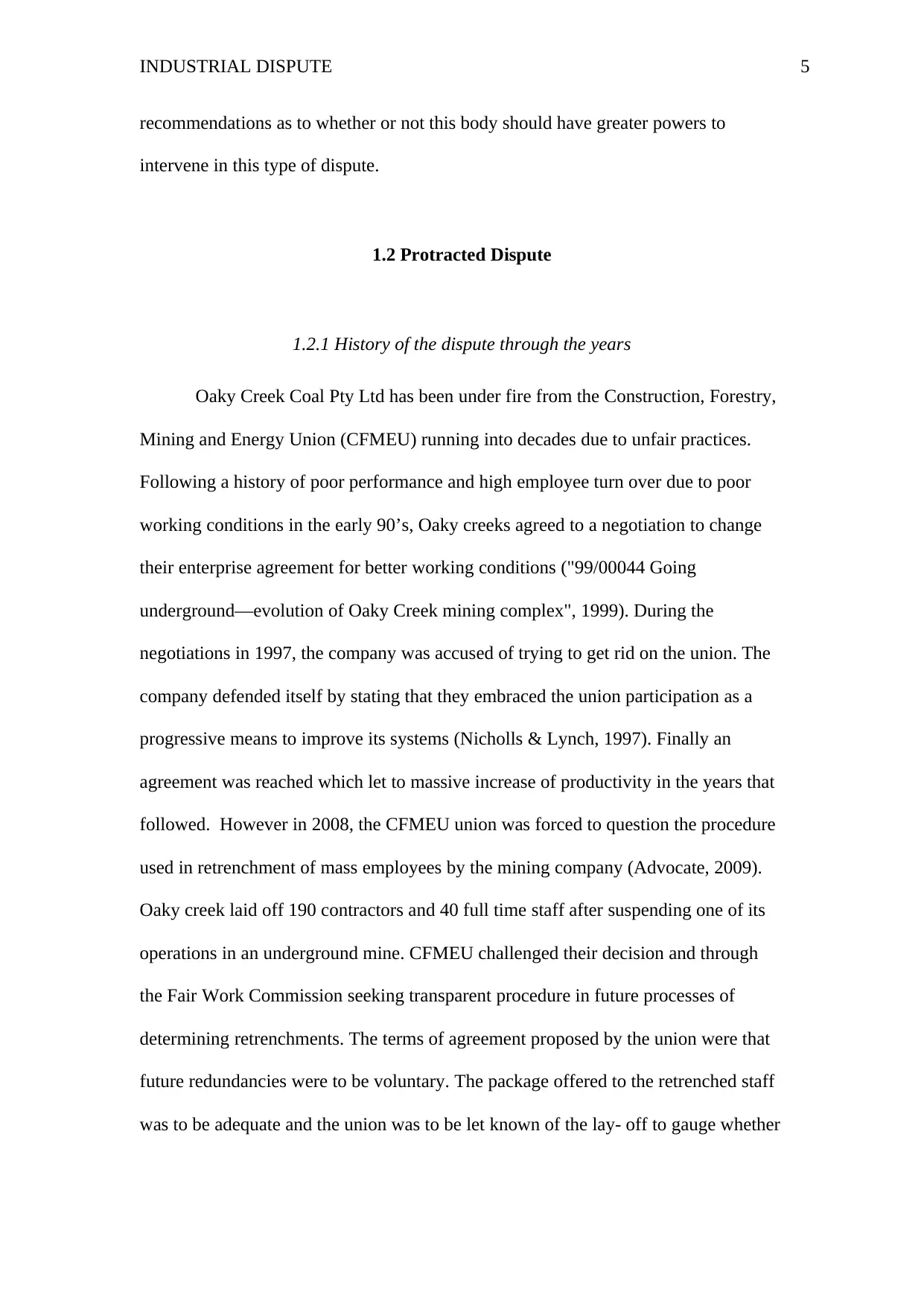
INDUSTRIAL DISPUTE 5
recommendations as to whether or not this body should have greater powers to
intervene in this type of dispute.
1.2 Protracted Dispute
1.2.1 History of the dispute through the years
Oaky Creek Coal Pty Ltd has been under fire from the Construction, Forestry,
Mining and Energy Union (CFMEU) running into decades due to unfair practices.
Following a history of poor performance and high employee turn over due to poor
working conditions in the early 90’s, Oaky creeks agreed to a negotiation to change
their enterprise agreement for better working conditions ("99/00044 Going
underground—evolution of Oaky Creek mining complex", 1999). During the
negotiations in 1997, the company was accused of trying to get rid on the union. The
company defended itself by stating that they embraced the union participation as a
progressive means to improve its systems (Nicholls & Lynch, 1997). Finally an
agreement was reached which let to massive increase of productivity in the years that
followed. However in 2008, the CFMEU union was forced to question the procedure
used in retrenchment of mass employees by the mining company (Advocate, 2009).
Oaky creek laid off 190 contractors and 40 full time staff after suspending one of its
operations in an underground mine. CFMEU challenged their decision and through
the Fair Work Commission seeking transparent procedure in future processes of
determining retrenchments. The terms of agreement proposed by the union were that
future redundancies were to be voluntary. The package offered to the retrenched staff
was to be adequate and the union was to be let known of the lay- off to gauge whether
recommendations as to whether or not this body should have greater powers to
intervene in this type of dispute.
1.2 Protracted Dispute
1.2.1 History of the dispute through the years
Oaky Creek Coal Pty Ltd has been under fire from the Construction, Forestry,
Mining and Energy Union (CFMEU) running into decades due to unfair practices.
Following a history of poor performance and high employee turn over due to poor
working conditions in the early 90’s, Oaky creeks agreed to a negotiation to change
their enterprise agreement for better working conditions ("99/00044 Going
underground—evolution of Oaky Creek mining complex", 1999). During the
negotiations in 1997, the company was accused of trying to get rid on the union. The
company defended itself by stating that they embraced the union participation as a
progressive means to improve its systems (Nicholls & Lynch, 1997). Finally an
agreement was reached which let to massive increase of productivity in the years that
followed. However in 2008, the CFMEU union was forced to question the procedure
used in retrenchment of mass employees by the mining company (Advocate, 2009).
Oaky creek laid off 190 contractors and 40 full time staff after suspending one of its
operations in an underground mine. CFMEU challenged their decision and through
the Fair Work Commission seeking transparent procedure in future processes of
determining retrenchments. The terms of agreement proposed by the union were that
future redundancies were to be voluntary. The package offered to the retrenched staff
was to be adequate and the union was to be let known of the lay- off to gauge whether
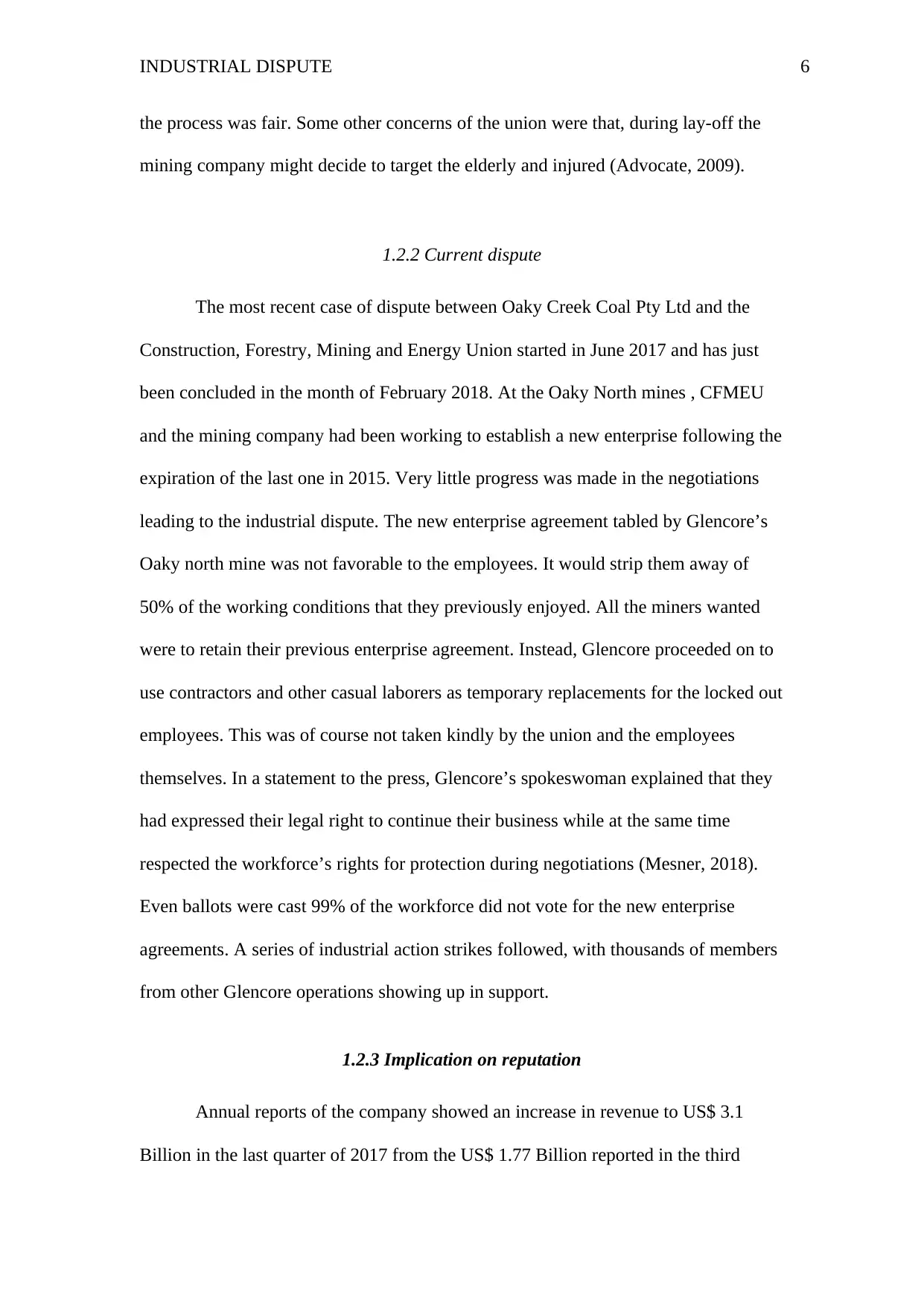
INDUSTRIAL DISPUTE 6
the process was fair. Some other concerns of the union were that, during lay-off the
mining company might decide to target the elderly and injured (Advocate, 2009).
1.2.2 Current dispute
The most recent case of dispute between Oaky Creek Coal Pty Ltd and the
Construction, Forestry, Mining and Energy Union started in June 2017 and has just
been concluded in the month of February 2018. At the Oaky North mines , CFMEU
and the mining company had been working to establish a new enterprise following the
expiration of the last one in 2015. Very little progress was made in the negotiations
leading to the industrial dispute. The new enterprise agreement tabled by Glencore’s
Oaky north mine was not favorable to the employees. It would strip them away of
50% of the working conditions that they previously enjoyed. All the miners wanted
were to retain their previous enterprise agreement. Instead, Glencore proceeded on to
use contractors and other casual laborers as temporary replacements for the locked out
employees. This was of course not taken kindly by the union and the employees
themselves. In a statement to the press, Glencore’s spokeswoman explained that they
had expressed their legal right to continue their business while at the same time
respected the workforce’s rights for protection during negotiations (Mesner, 2018).
Even ballots were cast 99% of the workforce did not vote for the new enterprise
agreements. A series of industrial action strikes followed, with thousands of members
from other Glencore operations showing up in support.
1.2.3 Implication on reputation
Annual reports of the company showed an increase in revenue to US$ 3.1
Billion in the last quarter of 2017 from the US$ 1.77 Billion reported in the third
the process was fair. Some other concerns of the union were that, during lay-off the
mining company might decide to target the elderly and injured (Advocate, 2009).
1.2.2 Current dispute
The most recent case of dispute between Oaky Creek Coal Pty Ltd and the
Construction, Forestry, Mining and Energy Union started in June 2017 and has just
been concluded in the month of February 2018. At the Oaky North mines , CFMEU
and the mining company had been working to establish a new enterprise following the
expiration of the last one in 2015. Very little progress was made in the negotiations
leading to the industrial dispute. The new enterprise agreement tabled by Glencore’s
Oaky north mine was not favorable to the employees. It would strip them away of
50% of the working conditions that they previously enjoyed. All the miners wanted
were to retain their previous enterprise agreement. Instead, Glencore proceeded on to
use contractors and other casual laborers as temporary replacements for the locked out
employees. This was of course not taken kindly by the union and the employees
themselves. In a statement to the press, Glencore’s spokeswoman explained that they
had expressed their legal right to continue their business while at the same time
respected the workforce’s rights for protection during negotiations (Mesner, 2018).
Even ballots were cast 99% of the workforce did not vote for the new enterprise
agreements. A series of industrial action strikes followed, with thousands of members
from other Glencore operations showing up in support.
1.2.3 Implication on reputation
Annual reports of the company showed an increase in revenue to US$ 3.1
Billion in the last quarter of 2017 from the US$ 1.77 Billion reported in the third
⊘ This is a preview!⊘
Do you want full access?
Subscribe today to unlock all pages.

Trusted by 1+ million students worldwide
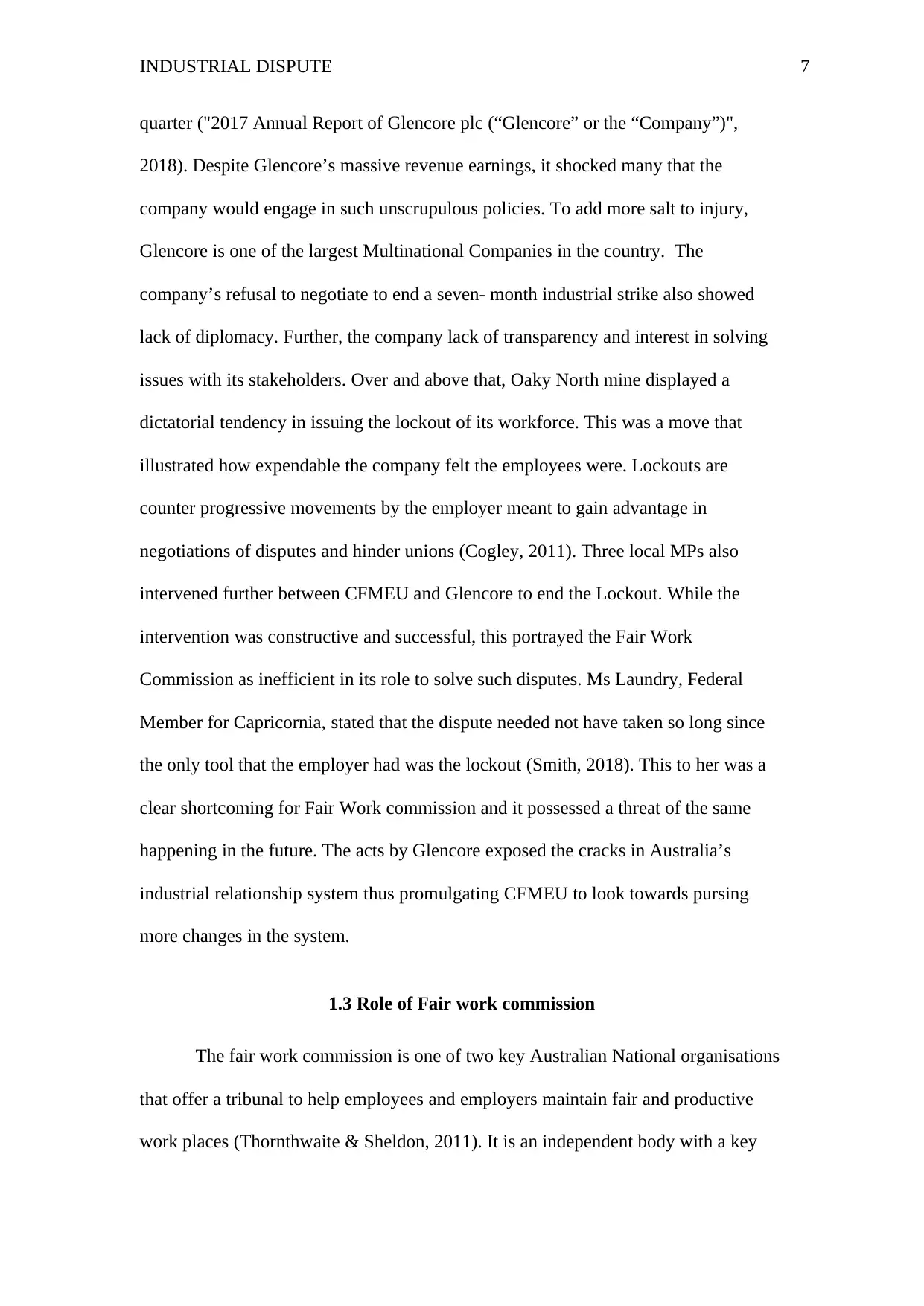
INDUSTRIAL DISPUTE 7
quarter ("2017 Annual Report of Glencore plc (“Glencore” or the “Company”)",
2018). Despite Glencore’s massive revenue earnings, it shocked many that the
company would engage in such unscrupulous policies. To add more salt to injury,
Glencore is one of the largest Multinational Companies in the country. The
company’s refusal to negotiate to end a seven- month industrial strike also showed
lack of diplomacy. Further, the company lack of transparency and interest in solving
issues with its stakeholders. Over and above that, Oaky North mine displayed a
dictatorial tendency in issuing the lockout of its workforce. This was a move that
illustrated how expendable the company felt the employees were. Lockouts are
counter progressive movements by the employer meant to gain advantage in
negotiations of disputes and hinder unions (Cogley, 2011). Three local MPs also
intervened further between CFMEU and Glencore to end the Lockout. While the
intervention was constructive and successful, this portrayed the Fair Work
Commission as inefficient in its role to solve such disputes. Ms Laundry, Federal
Member for Capricornia, stated that the dispute needed not have taken so long since
the only tool that the employer had was the lockout (Smith, 2018). This to her was a
clear shortcoming for Fair Work commission and it possessed a threat of the same
happening in the future. The acts by Glencore exposed the cracks in Australia’s
industrial relationship system thus promulgating CFMEU to look towards pursing
more changes in the system.
1.3 Role of Fair work commission
The fair work commission is one of two key Australian National organisations
that offer a tribunal to help employees and employers maintain fair and productive
work places (Thornthwaite & Sheldon, 2011). It is an independent body with a key
quarter ("2017 Annual Report of Glencore plc (“Glencore” or the “Company”)",
2018). Despite Glencore’s massive revenue earnings, it shocked many that the
company would engage in such unscrupulous policies. To add more salt to injury,
Glencore is one of the largest Multinational Companies in the country. The
company’s refusal to negotiate to end a seven- month industrial strike also showed
lack of diplomacy. Further, the company lack of transparency and interest in solving
issues with its stakeholders. Over and above that, Oaky North mine displayed a
dictatorial tendency in issuing the lockout of its workforce. This was a move that
illustrated how expendable the company felt the employees were. Lockouts are
counter progressive movements by the employer meant to gain advantage in
negotiations of disputes and hinder unions (Cogley, 2011). Three local MPs also
intervened further between CFMEU and Glencore to end the Lockout. While the
intervention was constructive and successful, this portrayed the Fair Work
Commission as inefficient in its role to solve such disputes. Ms Laundry, Federal
Member for Capricornia, stated that the dispute needed not have taken so long since
the only tool that the employer had was the lockout (Smith, 2018). This to her was a
clear shortcoming for Fair Work commission and it possessed a threat of the same
happening in the future. The acts by Glencore exposed the cracks in Australia’s
industrial relationship system thus promulgating CFMEU to look towards pursing
more changes in the system.
1.3 Role of Fair work commission
The fair work commission is one of two key Australian National organisations
that offer a tribunal to help employees and employers maintain fair and productive
work places (Thornthwaite & Sheldon, 2011). It is an independent body with a key
Paraphrase This Document
Need a fresh take? Get an instant paraphrase of this document with our AI Paraphraser
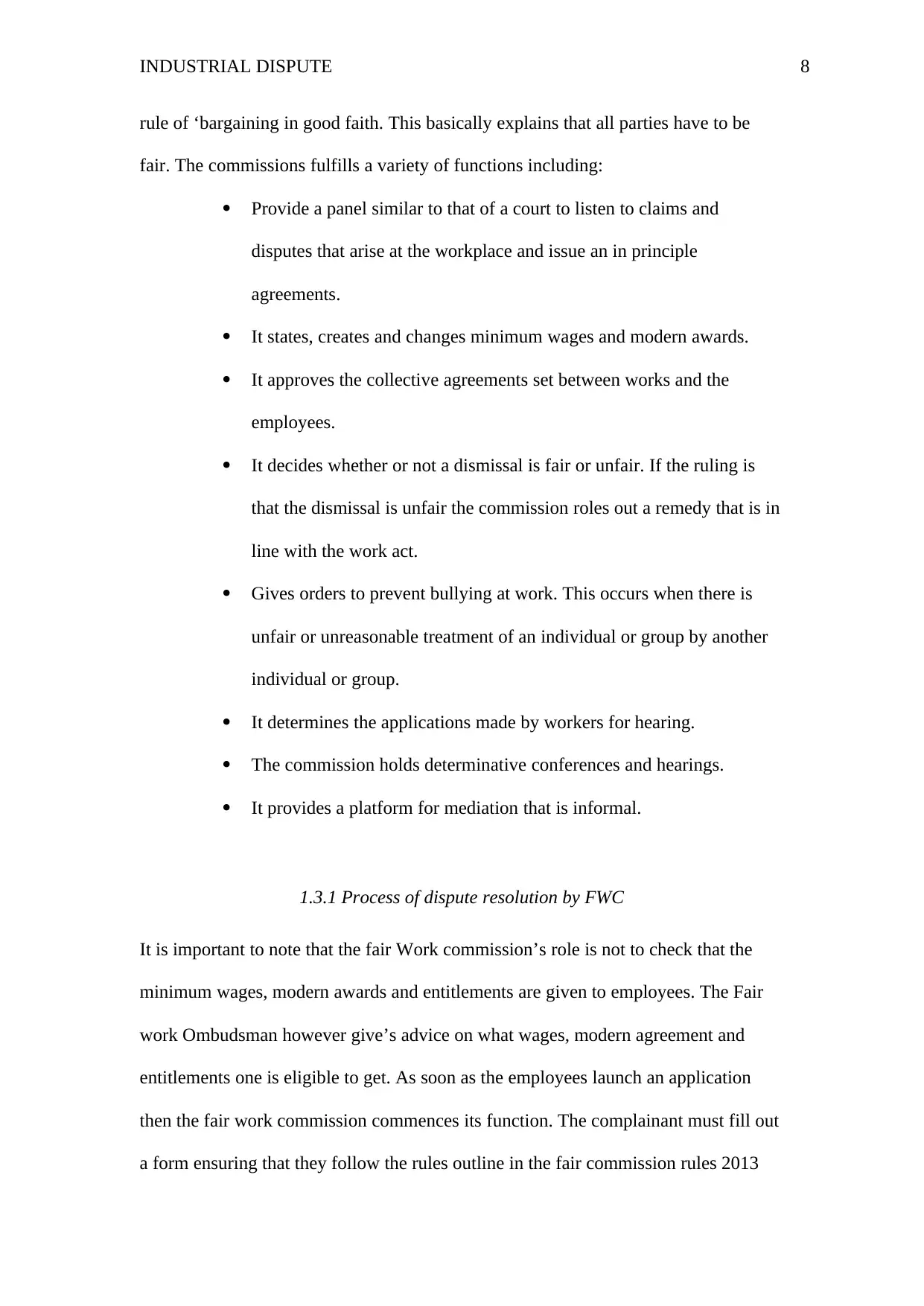
INDUSTRIAL DISPUTE 8
rule of ‘bargaining in good faith. This basically explains that all parties have to be
fair. The commissions fulfills a variety of functions including:
Provide a panel similar to that of a court to listen to claims and
disputes that arise at the workplace and issue an in principle
agreements.
It states, creates and changes minimum wages and modern awards.
It approves the collective agreements set between works and the
employees.
It decides whether or not a dismissal is fair or unfair. If the ruling is
that the dismissal is unfair the commission roles out a remedy that is in
line with the work act.
Gives orders to prevent bullying at work. This occurs when there is
unfair or unreasonable treatment of an individual or group by another
individual or group.
It determines the applications made by workers for hearing.
The commission holds determinative conferences and hearings.
It provides a platform for mediation that is informal.
1.3.1 Process of dispute resolution by FWC
It is important to note that the fair Work commission’s role is not to check that the
minimum wages, modern awards and entitlements are given to employees. The Fair
work Ombudsman however give’s advice on what wages, modern agreement and
entitlements one is eligible to get. As soon as the employees launch an application
then the fair work commission commences its function. The complainant must fill out
a form ensuring that they follow the rules outline in the fair commission rules 2013
rule of ‘bargaining in good faith. This basically explains that all parties have to be
fair. The commissions fulfills a variety of functions including:
Provide a panel similar to that of a court to listen to claims and
disputes that arise at the workplace and issue an in principle
agreements.
It states, creates and changes minimum wages and modern awards.
It approves the collective agreements set between works and the
employees.
It decides whether or not a dismissal is fair or unfair. If the ruling is
that the dismissal is unfair the commission roles out a remedy that is in
line with the work act.
Gives orders to prevent bullying at work. This occurs when there is
unfair or unreasonable treatment of an individual or group by another
individual or group.
It determines the applications made by workers for hearing.
The commission holds determinative conferences and hearings.
It provides a platform for mediation that is informal.
1.3.1 Process of dispute resolution by FWC
It is important to note that the fair Work commission’s role is not to check that the
minimum wages, modern awards and entitlements are given to employees. The Fair
work Ombudsman however give’s advice on what wages, modern agreement and
entitlements one is eligible to get. As soon as the employees launch an application
then the fair work commission commences its function. The complainant must fill out
a form ensuring that they follow the rules outline in the fair commission rules 2013
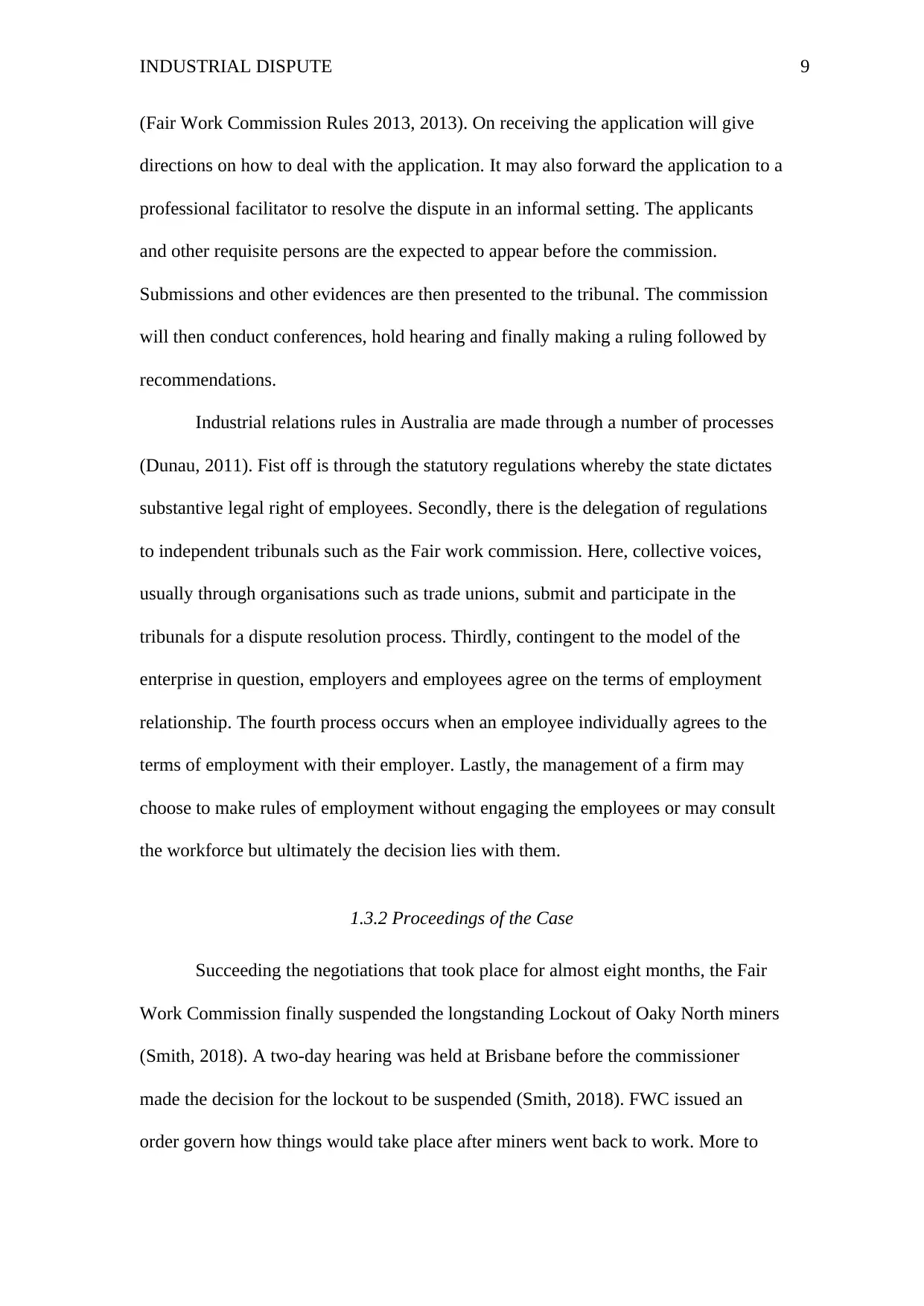
INDUSTRIAL DISPUTE 9
(Fair Work Commission Rules 2013, 2013). On receiving the application will give
directions on how to deal with the application. It may also forward the application to a
professional facilitator to resolve the dispute in an informal setting. The applicants
and other requisite persons are the expected to appear before the commission.
Submissions and other evidences are then presented to the tribunal. The commission
will then conduct conferences, hold hearing and finally making a ruling followed by
recommendations.
Industrial relations rules in Australia are made through a number of processes
(Dunau, 2011). Fist off is through the statutory regulations whereby the state dictates
substantive legal right of employees. Secondly, there is the delegation of regulations
to independent tribunals such as the Fair work commission. Here, collective voices,
usually through organisations such as trade unions, submit and participate in the
tribunals for a dispute resolution process. Thirdly, contingent to the model of the
enterprise in question, employers and employees agree on the terms of employment
relationship. The fourth process occurs when an employee individually agrees to the
terms of employment with their employer. Lastly, the management of a firm may
choose to make rules of employment without engaging the employees or may consult
the workforce but ultimately the decision lies with them.
1.3.2 Proceedings of the Case
Succeeding the negotiations that took place for almost eight months, the Fair
Work Commission finally suspended the longstanding Lockout of Oaky North miners
(Smith, 2018). A two-day hearing was held at Brisbane before the commissioner
made the decision for the lockout to be suspended (Smith, 2018). FWC issued an
order govern how things would take place after miners went back to work. More to
(Fair Work Commission Rules 2013, 2013). On receiving the application will give
directions on how to deal with the application. It may also forward the application to a
professional facilitator to resolve the dispute in an informal setting. The applicants
and other requisite persons are the expected to appear before the commission.
Submissions and other evidences are then presented to the tribunal. The commission
will then conduct conferences, hold hearing and finally making a ruling followed by
recommendations.
Industrial relations rules in Australia are made through a number of processes
(Dunau, 2011). Fist off is through the statutory regulations whereby the state dictates
substantive legal right of employees. Secondly, there is the delegation of regulations
to independent tribunals such as the Fair work commission. Here, collective voices,
usually through organisations such as trade unions, submit and participate in the
tribunals for a dispute resolution process. Thirdly, contingent to the model of the
enterprise in question, employers and employees agree on the terms of employment
relationship. The fourth process occurs when an employee individually agrees to the
terms of employment with their employer. Lastly, the management of a firm may
choose to make rules of employment without engaging the employees or may consult
the workforce but ultimately the decision lies with them.
1.3.2 Proceedings of the Case
Succeeding the negotiations that took place for almost eight months, the Fair
Work Commission finally suspended the longstanding Lockout of Oaky North miners
(Smith, 2018). A two-day hearing was held at Brisbane before the commissioner
made the decision for the lockout to be suspended (Smith, 2018). FWC issued an
order govern how things would take place after miners went back to work. More to
⊘ This is a preview!⊘
Do you want full access?
Subscribe today to unlock all pages.

Trusted by 1+ million students worldwide
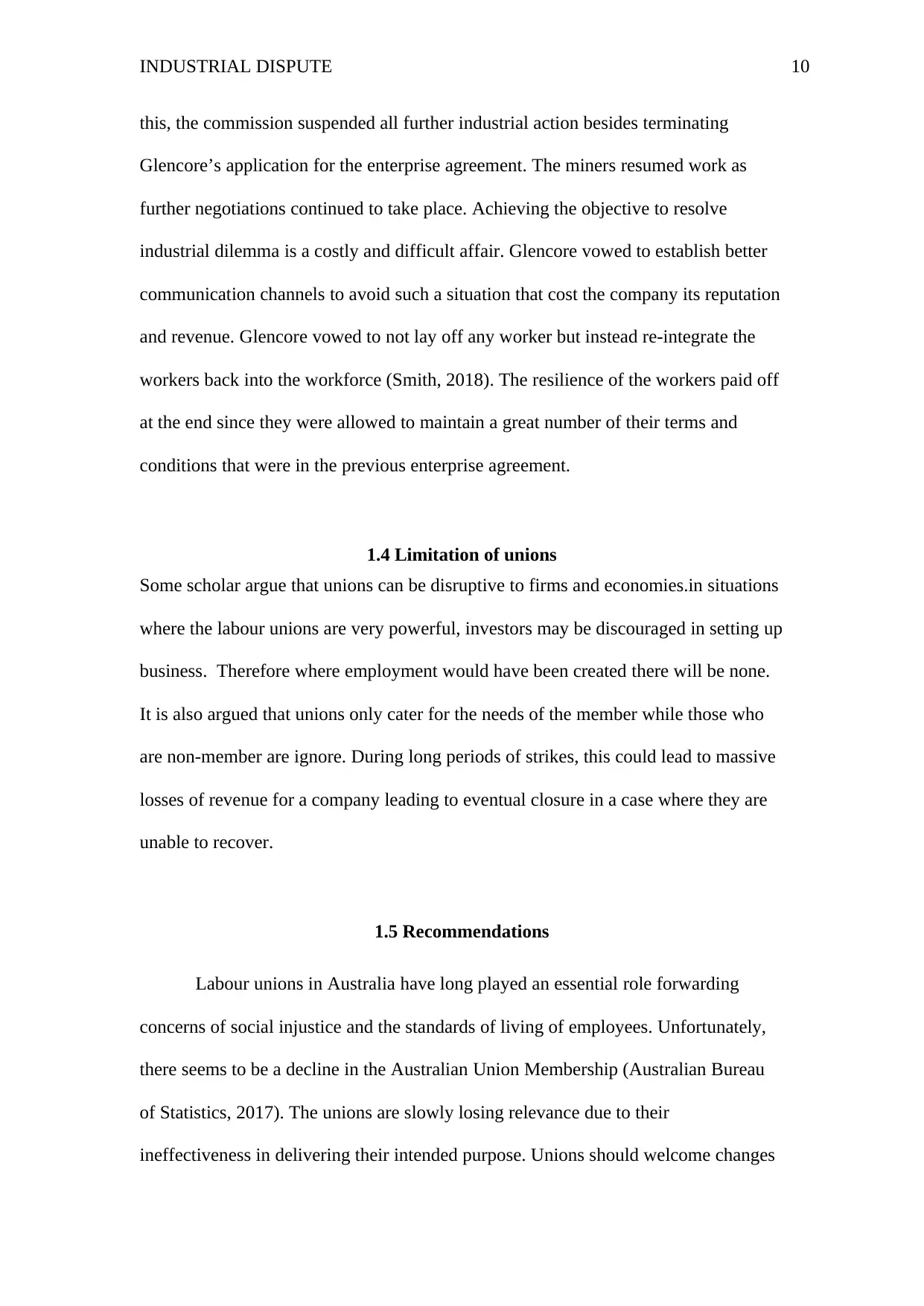
INDUSTRIAL DISPUTE 10
this, the commission suspended all further industrial action besides terminating
Glencore’s application for the enterprise agreement. The miners resumed work as
further negotiations continued to take place. Achieving the objective to resolve
industrial dilemma is a costly and difficult affair. Glencore vowed to establish better
communication channels to avoid such a situation that cost the company its reputation
and revenue. Glencore vowed to not lay off any worker but instead re-integrate the
workers back into the workforce (Smith, 2018). The resilience of the workers paid off
at the end since they were allowed to maintain a great number of their terms and
conditions that were in the previous enterprise agreement.
1.4 Limitation of unions
Some scholar argue that unions can be disruptive to firms and economies.in situations
where the labour unions are very powerful, investors may be discouraged in setting up
business. Therefore where employment would have been created there will be none.
It is also argued that unions only cater for the needs of the member while those who
are non-member are ignore. During long periods of strikes, this could lead to massive
losses of revenue for a company leading to eventual closure in a case where they are
unable to recover.
1.5 Recommendations
Labour unions in Australia have long played an essential role forwarding
concerns of social injustice and the standards of living of employees. Unfortunately,
there seems to be a decline in the Australian Union Membership (Australian Bureau
of Statistics, 2017). The unions are slowly losing relevance due to their
ineffectiveness in delivering their intended purpose. Unions should welcome changes
this, the commission suspended all further industrial action besides terminating
Glencore’s application for the enterprise agreement. The miners resumed work as
further negotiations continued to take place. Achieving the objective to resolve
industrial dilemma is a costly and difficult affair. Glencore vowed to establish better
communication channels to avoid such a situation that cost the company its reputation
and revenue. Glencore vowed to not lay off any worker but instead re-integrate the
workers back into the workforce (Smith, 2018). The resilience of the workers paid off
at the end since they were allowed to maintain a great number of their terms and
conditions that were in the previous enterprise agreement.
1.4 Limitation of unions
Some scholar argue that unions can be disruptive to firms and economies.in situations
where the labour unions are very powerful, investors may be discouraged in setting up
business. Therefore where employment would have been created there will be none.
It is also argued that unions only cater for the needs of the member while those who
are non-member are ignore. During long periods of strikes, this could lead to massive
losses of revenue for a company leading to eventual closure in a case where they are
unable to recover.
1.5 Recommendations
Labour unions in Australia have long played an essential role forwarding
concerns of social injustice and the standards of living of employees. Unfortunately,
there seems to be a decline in the Australian Union Membership (Australian Bureau
of Statistics, 2017). The unions are slowly losing relevance due to their
ineffectiveness in delivering their intended purpose. Unions should welcome changes
Paraphrase This Document
Need a fresh take? Get an instant paraphrase of this document with our AI Paraphraser
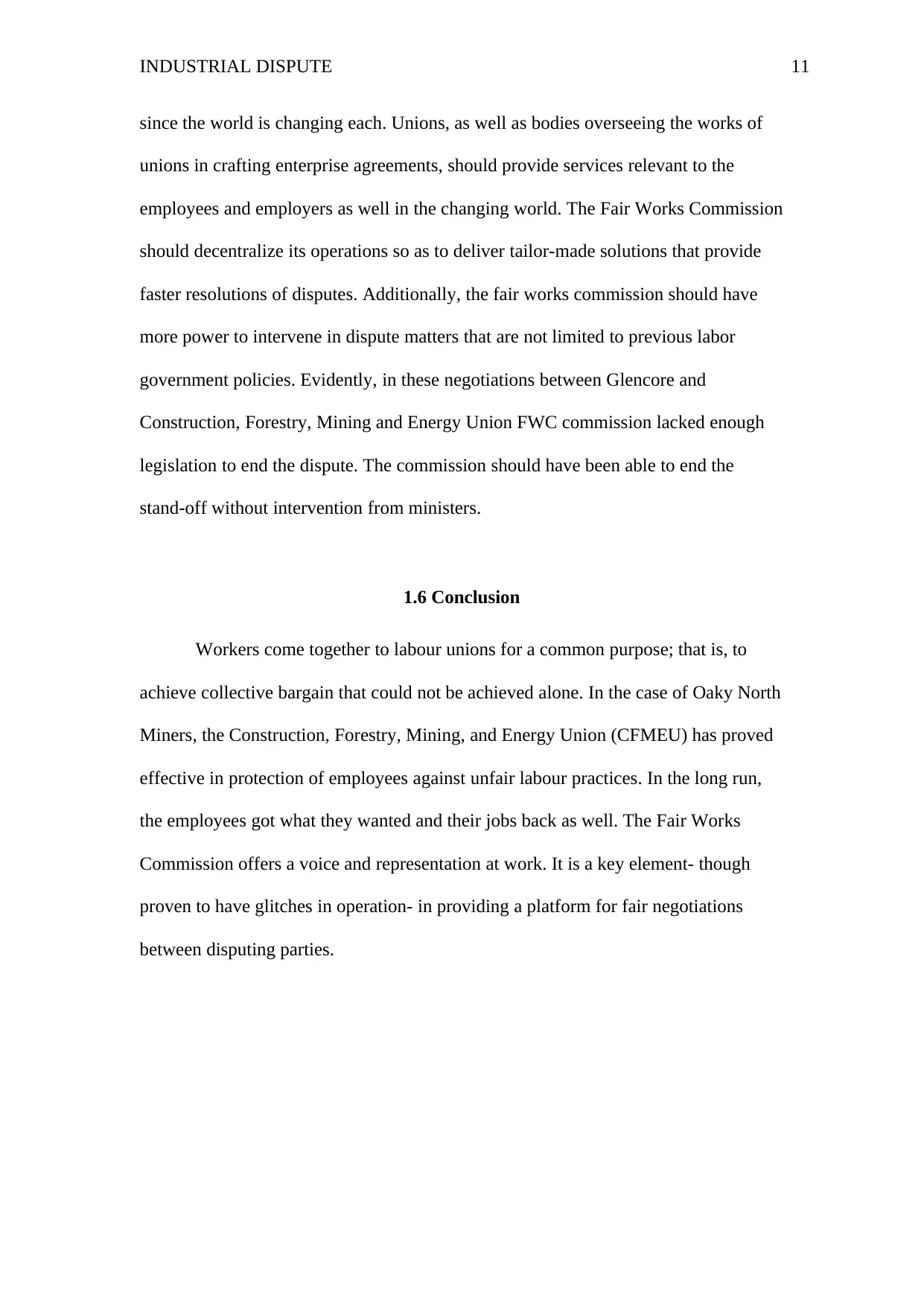
INDUSTRIAL DISPUTE 11
since the world is changing each. Unions, as well as bodies overseeing the works of
unions in crafting enterprise agreements, should provide services relevant to the
employees and employers as well in the changing world. The Fair Works Commission
should decentralize its operations so as to deliver tailor-made solutions that provide
faster resolutions of disputes. Additionally, the fair works commission should have
more power to intervene in dispute matters that are not limited to previous labor
government policies. Evidently, in these negotiations between Glencore and
Construction, Forestry, Mining and Energy Union FWC commission lacked enough
legislation to end the dispute. The commission should have been able to end the
stand-off without intervention from ministers.
1.6 Conclusion
Workers come together to labour unions for a common purpose; that is, to
achieve collective bargain that could not be achieved alone. In the case of Oaky North
Miners, the Construction, Forestry, Mining, and Energy Union (CFMEU) has proved
effective in protection of employees against unfair labour practices. In the long run,
the employees got what they wanted and their jobs back as well. The Fair Works
Commission offers a voice and representation at work. It is a key element- though
proven to have glitches in operation- in providing a platform for fair negotiations
between disputing parties.
since the world is changing each. Unions, as well as bodies overseeing the works of
unions in crafting enterprise agreements, should provide services relevant to the
employees and employers as well in the changing world. The Fair Works Commission
should decentralize its operations so as to deliver tailor-made solutions that provide
faster resolutions of disputes. Additionally, the fair works commission should have
more power to intervene in dispute matters that are not limited to previous labor
government policies. Evidently, in these negotiations between Glencore and
Construction, Forestry, Mining and Energy Union FWC commission lacked enough
legislation to end the dispute. The commission should have been able to end the
stand-off without intervention from ministers.
1.6 Conclusion
Workers come together to labour unions for a common purpose; that is, to
achieve collective bargain that could not be achieved alone. In the case of Oaky North
Miners, the Construction, Forestry, Mining, and Energy Union (CFMEU) has proved
effective in protection of employees against unfair labour practices. In the long run,
the employees got what they wanted and their jobs back as well. The Fair Works
Commission offers a voice and representation at work. It is a key element- though
proven to have glitches in operation- in providing a platform for fair negotiations
between disputing parties.
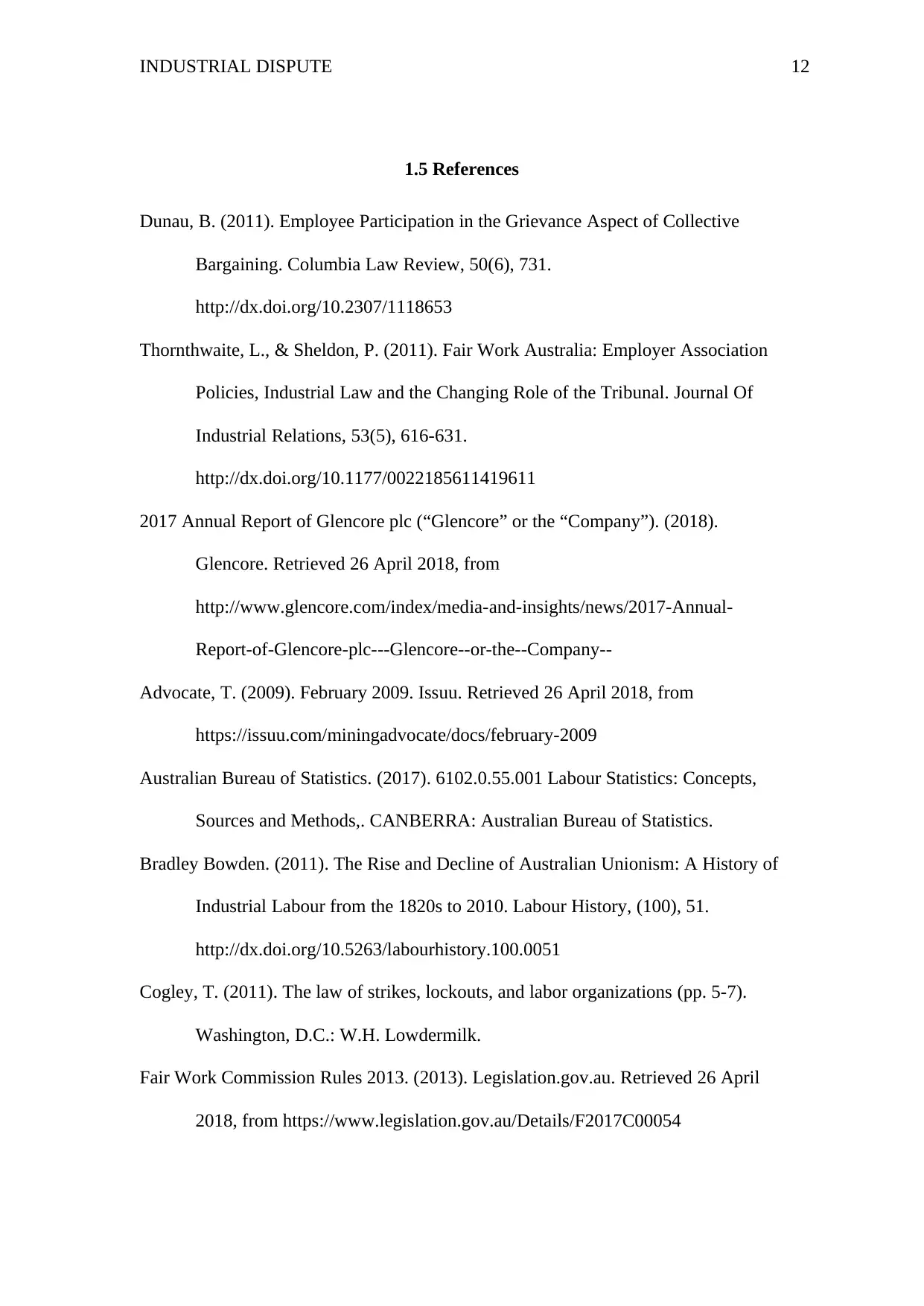
INDUSTRIAL DISPUTE 12
1.5 References
Dunau, B. (2011). Employee Participation in the Grievance Aspect of Collective
Bargaining. Columbia Law Review, 50(6), 731.
http://dx.doi.org/10.2307/1118653
Thornthwaite, L., & Sheldon, P. (2011). Fair Work Australia: Employer Association
Policies, Industrial Law and the Changing Role of the Tribunal. Journal Of
Industrial Relations, 53(5), 616-631.
http://dx.doi.org/10.1177/0022185611419611
2017 Annual Report of Glencore plc (“Glencore” or the “Company”). (2018).
Glencore. Retrieved 26 April 2018, from
http://www.glencore.com/index/media-and-insights/news/2017-Annual-
Report-of-Glencore-plc---Glencore--or-the--Company--
Advocate, T. (2009). February 2009. Issuu. Retrieved 26 April 2018, from
https://issuu.com/miningadvocate/docs/february-2009
Australian Bureau of Statistics. (2017). 6102.0.55.001 Labour Statistics: Concepts,
Sources and Methods,. CANBERRA: Australian Bureau of Statistics.
Bradley Bowden. (2011). The Rise and Decline of Australian Unionism: A History of
Industrial Labour from the 1820s to 2010. Labour History, (100), 51.
http://dx.doi.org/10.5263/labourhistory.100.0051
Cogley, T. (2011). The law of strikes, lockouts, and labor organizations (pp. 5-7).
Washington, D.C.: W.H. Lowdermilk.
Fair Work Commission Rules 2013. (2013). Legislation.gov.au. Retrieved 26 April
2018, from https://www.legislation.gov.au/Details/F2017C00054
1.5 References
Dunau, B. (2011). Employee Participation in the Grievance Aspect of Collective
Bargaining. Columbia Law Review, 50(6), 731.
http://dx.doi.org/10.2307/1118653
Thornthwaite, L., & Sheldon, P. (2011). Fair Work Australia: Employer Association
Policies, Industrial Law and the Changing Role of the Tribunal. Journal Of
Industrial Relations, 53(5), 616-631.
http://dx.doi.org/10.1177/0022185611419611
2017 Annual Report of Glencore plc (“Glencore” or the “Company”). (2018).
Glencore. Retrieved 26 April 2018, from
http://www.glencore.com/index/media-and-insights/news/2017-Annual-
Report-of-Glencore-plc---Glencore--or-the--Company--
Advocate, T. (2009). February 2009. Issuu. Retrieved 26 April 2018, from
https://issuu.com/miningadvocate/docs/february-2009
Australian Bureau of Statistics. (2017). 6102.0.55.001 Labour Statistics: Concepts,
Sources and Methods,. CANBERRA: Australian Bureau of Statistics.
Bradley Bowden. (2011). The Rise and Decline of Australian Unionism: A History of
Industrial Labour from the 1820s to 2010. Labour History, (100), 51.
http://dx.doi.org/10.5263/labourhistory.100.0051
Cogley, T. (2011). The law of strikes, lockouts, and labor organizations (pp. 5-7).
Washington, D.C.: W.H. Lowdermilk.
Fair Work Commission Rules 2013. (2013). Legislation.gov.au. Retrieved 26 April
2018, from https://www.legislation.gov.au/Details/F2017C00054
⊘ This is a preview!⊘
Do you want full access?
Subscribe today to unlock all pages.

Trusted by 1+ million students worldwide
1 out of 15
Related Documents
Your All-in-One AI-Powered Toolkit for Academic Success.
+13062052269
info@desklib.com
Available 24*7 on WhatsApp / Email
![[object Object]](/_next/static/media/star-bottom.7253800d.svg)
Unlock your academic potential
Copyright © 2020–2025 A2Z Services. All Rights Reserved. Developed and managed by ZUCOL.




